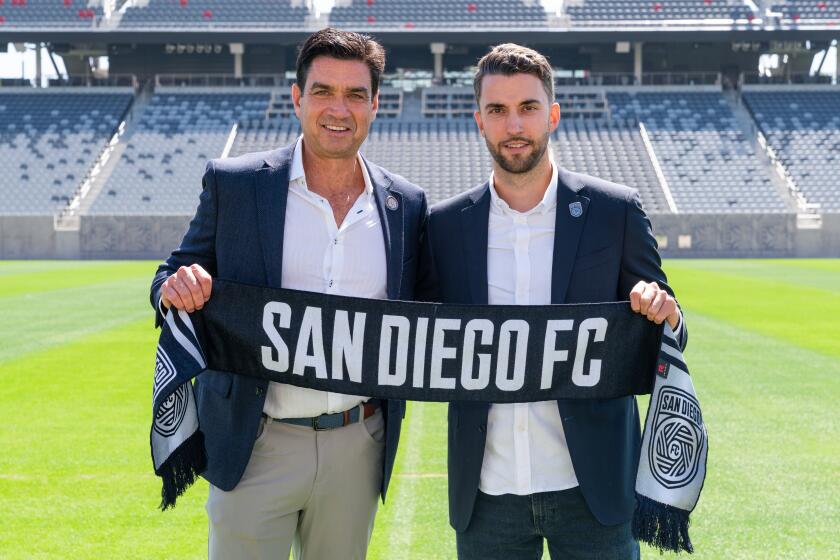Hernandez Deal Good for Galaxy, League
So, is this a good deal, or what?
Has the Galaxy done the right thing in shedding four players, three of them starters, to receive one 31-year-old Mexican striker?
That question will be asked frequently in the coming weeks once fans begin to assess the impact Luis Hernandez may have on the so-far-unbeaten team and, more important, what effect the losses of Steve Jolley, Clint Mathis, Joe Franchino and Roy Myers have.
There is no doubt about Hernandez’s ability. He is one of the world’s most recognizable and deft goal scorers, having proved that at club and international levels.
But was it fair of MLS to have extracted such a high price from the Galaxy--not to mention the $4 million or so that owner Phil Anschutz supposedly is kicking in to buy Hernandez?
The answer is yes, and here’s why:
* Jolley was not part of the Hernandez equation. He was not starting for the Galaxy, was unhappy and ultimately was traded to the New York/New Jersey MetroStars, where former Galaxy and now MetroStar Coach Octavio Zambrano was only too pleased to accept him.
* Mathis and Franchino are young American players who have made their marks in the league and will continue to do so. But any coach in his right mind takes Hernandez over Mathis at forward every day of the week. It’s not even close. And Los Angeles has more than able replacements for Franchino at left back in Paul Caligiuri and Greg Vanney.
* Myers would have had to leave anyway had Mexican striker Carlos Hermosillo stayed with the Galaxy. It’s a salary-cap issue. When Hermosillo bailed, Myers got a reprieve. Now that Hernandez appears to be coming, Myers once again is too expensive to keep and this week he rejoins the MetroStars.
So, no, it wasn’t a case of the Galaxy giving up four for one.
In Hernandez, Los Angeles will get a top-flight striker for the next three years, and the MetroStars, an ailing club that MLS desperately needs to succeed, will be significantly strengthened.
That’s what the league intends to achieve as a single-entity structure. Fans might not like it, many might see it as bogus, but until they start coming out in much greater numbers and thereby give MLS a greater level of financial stability, single entity will be the name of the game.
A ROOF, A ROOF, PLEASE
Sometime in the not-too-distant future, Tim Leiweke, president of the Galaxy and the NHL’s Kings, will travel to London, where he will find his way to White Hart Lane.
That, as every fan worth a season ticket knows, is the North London home of the Tottenham Hotspur Football Club, better knows as Spurs.
Leiweke is going there to check out the stadium roof. Or, more to the point, the ambience that having a roof over the stands brings to the field. Almost all European club stadiums are tightly enclosed, even snug, places where the crowd noise reverberates from touchline to touchline. It can be deafening and, to opponents, intimidating.
That’s what Galaxy Coach Sigi Schmid desires for the team’s proposed 30,000-seat stadium on the Cal State Dominguez Hills campus in Carson. Putting a roof on the structure is essential to creating the atmosphere Schmid prefers.
Leiweke’s visit to White Hart Lane was arranged by Juergen Klinsman, the retired German World Cup winner who occasionally trains with the Galaxy. Klinsman used to play for Spurs.
Schmid, correctly, is trying to persuade Leiweke that the roofing business is a good way to go.
“I showed him a book of all the German [Bundesliga] stadiums and said, ‘Notice, these are the stadiums for the 2006 World Cup; they all have a roof,’ ” Schmid said. “So we’re definitely making headway in that regard.”
A GERMAN CUP?
The decision, incidentally, on where the 2006 World Cup will be played will be made by FIFA in Zurich, Switzerland, on July 5 or 6. England, Germany and South Africa are the front-runners, with Brazil and Morocco trailing.
But South Africa’s appalling crime statistics and England’s inability to eradicate hooliganism have insiders now predicting that FIFA will opt for Germany.
The hooligan problem might come into sharper focus during Euro 2000, the June 10-July 2 European Championship being jointly staged by Belgium and the Netherlands.
England and Germany are in the same first-round group and will play each other in the small, southern Belgian town of Charleroi on June 17. Thousands of police will be deployed to prevent clashes between rival fans, but any serious violence from English hooligans--as in Marseille at the France ’98 World Cup--will mean the end to England’s World Cup 2006 hopes.
“A disastrous Euro 2000 with the hooligans would undermine everything we have worked so hard for,” said Sir Bobby Charlton, England’s 1966 World Cup winner and the man heading England’s 2006 bid.
He said the June 17 match has “an obvious potential for trouble.”
18 FOR DOWN UNDER
April Heinrichs, the U.S. women’s national team coach, has given a broad hint at who might be going to the Sydney 2000 Olympics by her selection of 18 players for the upcoming Pacific Cup in Australia.
Heinrichs on Friday named 13 players from the 1999 Women’s World Cup-winning team to her roster for the six-nation tournament to be played May 31-June 11, excluding Carla Overbeck, who has undergone minor knee surgery, and Michelle Akers, who is rehabilitating from shoulder surgery.
The five non-World Cup winners selected are goalkeeper Siri Mullinix, defender Danielle Slaton, midfielders Aly Wagner and Nikki Serlenga, and forward Christie Welsh.
Goalkeeper Briana Scurry and winger Shannon MacMillan probably will play their 100th matches for the national team during the tournament. Only 10 U.S. women have reached the century mark before.







